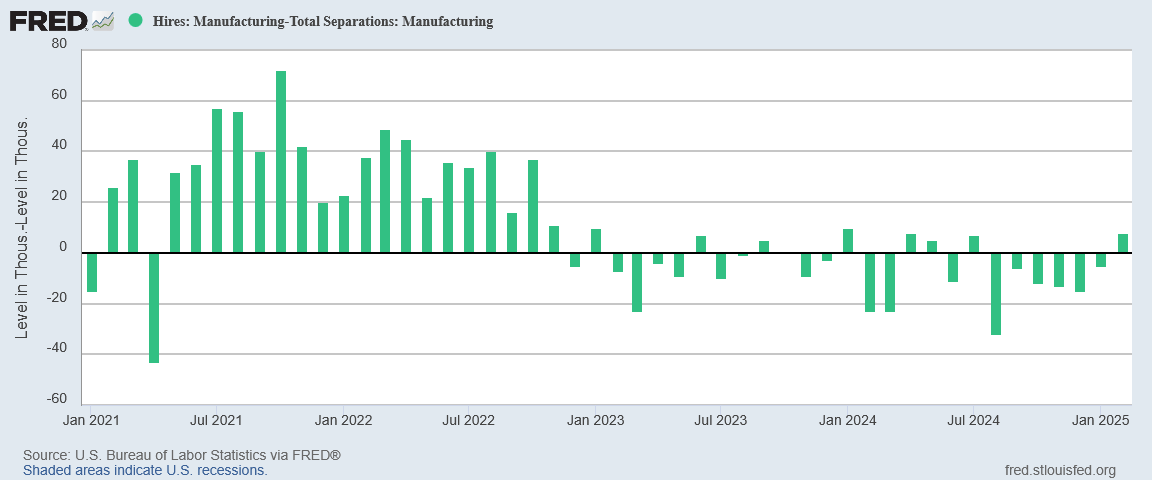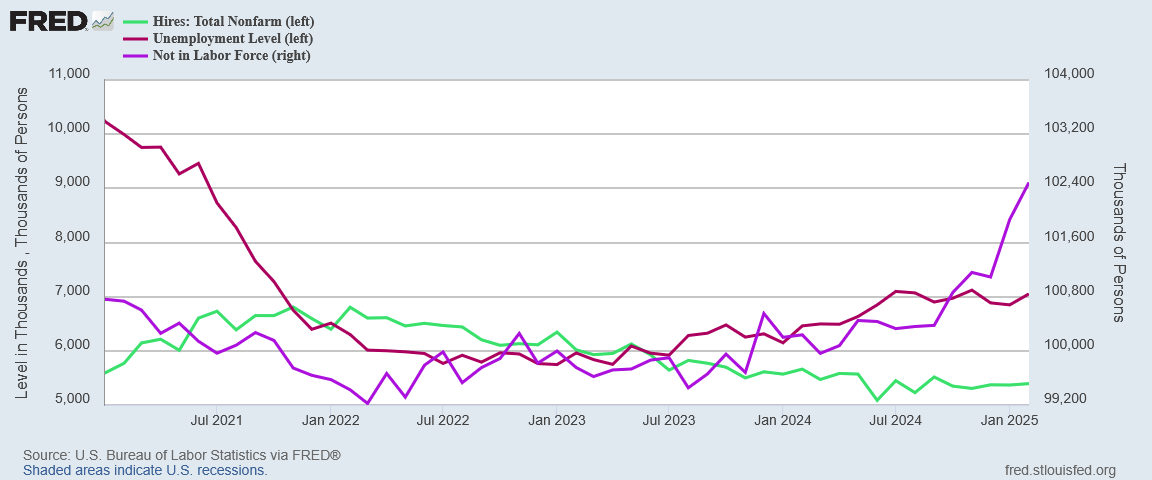Another month has come and gone, and another Job Openings and Labor Turnover Summary Report (JOLTS) has come out.
Another month has come and gone, and another JOLTS Report claims that employment in this country is “little changed.” Again.
The number of job openings was little changed at 7.6 million in February, the U.S. Bureau of Labor Statistics reported today. Over the month, hires and total separations held at 5.4 million and 5.3 million, respectively. Within separations, quits (3.2 million) and layoffs and discharges (1.8 million) changed little.
Someone needs to send Elon Musk and the boys from DOGE over to the Bureau of Labor Statistics to see which AI Chatbot afflicted with model rot is writing their report summaries. “Little changed” and “changed little” have been the summation of the JOLTS report for a number of months now. Surely by now something would have changed.
As it turns out a few things have changed—just not for the better. The overall takeaway from the JOLTS report is that labor markets in the United States are still mired in a jobs recession. Instead of getting a sudden corrective shock however, US labor markets are being subjected to the economic equivalent of the death of the ten thousand cuts.
Fake Job Openings Declined (Sort Of)
Perhaps the most obvious—and irrelevant—change reported in the Summary was the decline in the number of fake job openings, which fell by 194,000 in February.
What has “changed little” is that the job openings themselves are largely nonexistent and made-up, a point I have discussed many times before.
With reported job openings having stayed so far above hiring and separations, for so long, it is a virtual certainty that a large percentage of the reported job openings exist only on paper, and most of the rest simply do not exist at all.
Howvever, we need to put a caveat on the decline in job openings: since last fall the number of job openings has actually trended up.
Reported job openings increased significantly in October and November of last year, and are still not yet down to where they were last September.
With hiring trends being either flat or trending down, the longer-term upward trend in job openings serves to further underscore how illusory real job growth has been in the US. Available job openings simply are not accurately tracking to hiring rates—a virtual impossibility for legitimate hiring.
Hiring Mixed
Hiring trends have been mixed for most of 2024 and into 2025. February was no different.
After slumping in the first half of 2024, the pace of hiring in the second half of the year slowly trended upwards, while the pace of separations has moved up, albeit by a lesser amount than the pace of hiring.
As a result, net hiring—the difference between hires and separations—did improve slightly in February.
However, the month-on-month improvement in net hiring stands in stark contrast to the overall decline in net hiring over the past few years.
Relative to 2021 and 2022, hiring gains over the past two years have been anemic at best, bordering on nonexistent.
That weakness becomes even more apparent when we drill down into various labor market sectors.
While manufacturing registered net hiring improvement in February, for the past two years manufacturing has been largely a tale of job loss, not job gains.
Trade, Transportation, and Utilities has seen stronger job gains than manufacturing, but not by much.
Over the past two years, Professional and Business Services has shed jobs more months than it has gained jobs.
Even Leisure and Hospitality has seen weak and problematic growth over the past two years relative to 2021 and 2022.
The JOLTS report simply is not a report containing much good news in the way of job creation. Instead, the JOLTS report charts a steady decline in hiring since 2022 across multiple economic sectors.
Healthy jobs markets are those where the pace of hiring is generally increasing, and where job creation is not sporadic and problematic. The United States has not had healthy job markets for a quite some time now.
Joblessness Still Growing
As hiring has declined in the United States, joblessness has risen. The correlation between the two phenomena is easily understood and demonstrably obvious.
Indeed, the JOLTS report makes nothing quite so clear as the impact of declining hiring on labor markets—more and more people either unemployed or out of the labor force entirely.
Yet it is not just that a lack of hiring is producing joblessness. More workers are being forced out of work rather than choosing to quit their jobs voluntarily, and that shift coincides with a general rise in joblessness.
This shift from voluntary to involuntary job separations has been underway since 2022, making it a significant factor in the ongoing jobs recession in the United States.
As an increasing number of people opt to remain at their jobs, an increasing number of employers are opting to separate people from those jobs.
It scarcely needs saying that such trends are the antithesis of what one would see in healthy labor markets. It also scarcely needs saying—yet again—that healthy labor markets are not something the United States has had for a number of years now.
Perhaps the most glaring thing about the monthly JOLTS report that does not change is this fundamental dysfunction within US labor markets, which has been a fixture going back almost to the 2020 COVID Pandemic Panic.
No Jobs Recovery Yet
I have for the past several months argued that the United States has been experiencing a jobs recession since at least November of 2023.
With all its data that, according to the BLS, changes little, the JOLTS report does an excellent job of showcasing just how broad and enduring that jobs recession is.
Indeed, it was just over a year ago that I noted how the most glaring deficiency in the JOLTS report at that time was a lack of meaningful change, which was tantamount to a lack of job growth and employment in the United States.
As the current JOLTS report shows, the jobs situation has not improved in this country since then. Rather, it has continued to muddle through, stagnating instead of producing an engaged, dynamic, and broadly growing labor force.
That deteroriation in US labor markets was especially noticeable at the end of 2024, without much improvement if any since then.
While consumers—and voters—are routinely expressing greater concern over issues such as inflation, the economic reality is that lack of employment and lack of employment opportunity—which all too frequently results in stagnating wages as well—is what gives inflationary price rises their economic significance. Without a general upward trend in the number of people working, there is little to produce an upward trend in wages. Without wage growth, every upward trend in consumer prices becomes more and more painful to workers—who, we must remember, are also consumers.
The narrative of the JOLTS report is not one of dramatic change. There is no shock to labor markets either good or bad. In this regard, the “little changed” tenor of the BLS’ “bureaucratese” regarding labor markets in this country is broadly correct.
However, what is invariably the case is that this lack of significant change—this lack of dynamism and vitality—means that labor markets in the United States are constantly and steadily declining.
Hiring is deteriorating, and the JOLTS report shows this all too clearly.
Joblessness is increasing, and the JOLTS report shows this all too clearly as well.
The breadth of labor market dysfunction, and the longevity of that dysfunction, have combined within the Job Openings and Labor Turnover Summary once again to produce a narrative of ongoing weakness and decline. Instead of single episode of dramatic labor market collapse, with the JOLTS report we get an ongoing death of ten thousand cuts. Instead of a labor shock we are getting persisent, inexorable, and seemingly unstoppable labor market decline.
And that does not sound like anyone’s notion of a “good” news, economic or otherwise.























Peter, you have such a talent for data analysis! By contrast, I have an image of the bureaucrats at this agency just pretending to work while they’re actually drinking coffee and playing online Solitaire.
The bad news is that the corporate media will finally pay attention to the jobs recession now that they can - inaccurately - blame it on Trump. And they will.
Peter, a naive question: why would companies advertise “fake” job openings? Is it because they don’t want to chill their ability to recruit if and when the business climate improves?